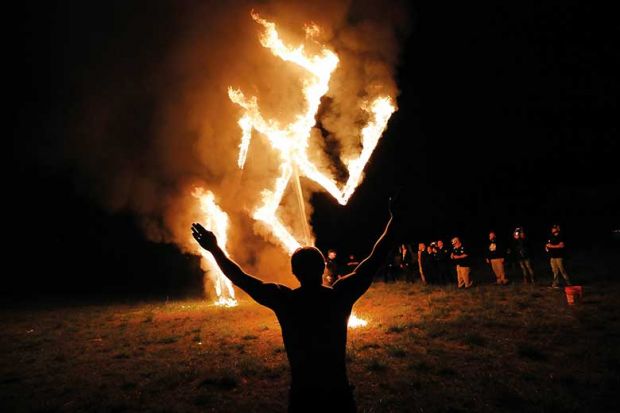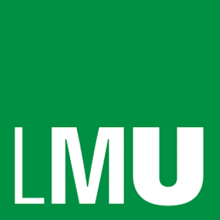A spectre is haunting the world: the spectre of Nazism – of, in the title of Gavriel Rosenfeld’s book, The Fourth Reich. This ghost haunts our past, in our awareness and memory of the crimes of the Nazis. It haunts our present, emerging everywhere from catch-all insults shouted out at politicians outside Westminster to Godwin’s Law, “a facetious aphorism” admitted to the Oxford English Dictionary in 2012 “maintaining that as an online debate increases in length, it becomes inevitable that someone will eventually compare someone or something to Adolf Hitler or the Nazis”.
Following Hans Ulrich Gumbrect’s gripping memoir/philosophical investigation, After 1945: Latency as Origin of the Present (2013), we could see both of these as examples of how the memory of the Nazi epoch emerges in the present from our cultural unconscious in odd and sometimes contradictory ways. But worse, a Fourth Reich, no longer located in Germany but elsewhere, haunts our visions of the future as we look around Europe (Hungary, Poland, growing extreme parties everywhere), further east and even – with wild surmise – west across the Atlantic.
The study of this kind of conceptual haunting is now a small academic industry, started by Jacques Derrida’s Spectres of Marx (1993). This meditation on Marx’s legacy begins by discussing the ghost of Old Hamlet on the battlements of Elsinore. The ghost is both there (the old king) and not-there (it’s not him, but his spirit). We must, like Hamlet, speak to it, hear the injunction placed on the present from the past for the future, but learn to judge its importance for ourselves. Rosenfeld’s investigation, too, is a “hauntology”: at “its core”, he writes, “the history of the Fourth Reich is the story of an ontological paradox. It has never come into being, but it has never disappeared. It draws on memories of a traumatic past, but expresses fears of an unknown future. Its meaning is both particular and universal.” This is a canny way of drawing out one crucial strand of the huge and still-present impact of the Second World War on Europe and the world.
To deal with this “ontological paradox”, Rosenfeld’s hauntology adds two tools to the usual historian’s box. First, while some eschew art or fiction, Rosenfeld concurs with the great Holocaust historian Saul Friedländer, who argues that artworks can present the “reality of the past in a way that sometimes reveals previously unsuspected aspects” – and so he turns to novels, films, comics as sources. Second, and developing his own work in this area, Rosenfeld uses “What ifs?” or counterfactuals, citing Hugh Trevor-Roper, “history is not merely what happened: it is what happened in the context of what might have happened”. Here, and especially in his account of the 20 years or so after the war, this is very insightful, precisely because it neatly shows how spooked both Germany and the Allies were by the possibilities of a resurgent Reich.
In contrast, more traditionally minded historians might cavil a little at the rather narrow range of other sources, noting that the book relies a great deal on the US and British press. (One wonders: how far is the Daily Mail a sound newspaper of record in this particular field?)
Before the Second World War, the idea of the Fourth Reich existed in the work of political mystics and progressive opponents of the Third Reich. During the war, these notions of a benign, messianic coming kingdom disappeared. Instead, the term was used by opponents of the Nazis and signified the opposite: books such as Erwin Lesser’s Phantom Victory: A Fictional History of the Fourth Reich (1944) posited a revived Nazi Germany rising from defeat. In the immediate aftermath of the war, the Fourth Reich played an even larger role in the consciousness of both the occupying forces and the Germans. The melodramatically named “Werewolf” units fought a small-scale and largely ineffective insurgency in its name. The revival of the Reich was the focus of two equally derisible post-war Nazi plots (put down by “Operation Nursery” and “Operation Selection Board”: one imagines the Allied officers choosing these apt names with some glee). But it is in the 1950s, and in the most detailed sections of the book, that Rosenfeld traces the growth of the idea of the Fourth Reich in Germany in a nascent extreme right wing. What if Adenauer had failed? What if Germany had not had an “economic miracle” in the early 1950s? These kind of counterfactuals reveal the power of the idea of the Fourth Reich.
In parallel with the growth of awareness of the terrible crimes that came, during the 1960s, to be called the Holocaust, so the idea of the Fourth Reich spread more widely and to the US. Civil rights and anti-Vietnam War activists decried the US as the “Fourth Reich”. But, as is the way of things, the term also became less serious, applied to dance bands, motorcycle gangs, even a surge of new German restaurants in Houston. The theme grew, too, in popular culture. The late 1960s and 1970s saw fiction, comics and films about a resurrected Reich: episodes of Mission Impossible, The Boys from Brazil, The Odessa File, the never-ending war between Captain America and the Red Skull and his quasi-Nazi organisation (“Heil Hydra!”). The Nazis always made excellent “off the shelf” enemies, allowing the former Allied powers to portray themselves as unquestioningly “good” by contrast, and so perhaps quieten doubts about, say, Vietnam. But through the 1980s, the fear of a Fourth Reich receded: indeed, Rosenfeld cites academic experts assuring Margaret Thatcher that German reunification was not a threat and that there was “no danger of a Fourth Reich”. The book concludes that the Fourth Reich has now become a global, vague and exhausted icon of evil: yet, Rosenfeld warns, it may still return in some form.
This thought of the return of Nazism is certainly present in much recent work by historians. I’m thinking, for example, of Timothy Snyder’s bestselling booklet On Tyranny: Twenty Lessons from the Twentieth Century (2017), which draws on this ghost. Less alarmist but more fully explored is the argument of Dan Stone (my Royal Holloway colleague) in his prescient Goodbye to All That?: The Story of Europe since 1945 (2013), where he argues that the decline of social democracy in the West, aggravated by the 2008 crisis, and the end of the Cold War and anti-fascist consensus has led to a rise in right-wing populism. Abetted by phenomenal social and political changes enabled by the internet, this directs “people’s justifiable anger over the loss of most of the certainties that enabled post war stability” not at those “dismantling those structures” but towards marginalised “others”.
Stone’s point is not that history is repeating itself, but that we may be in circumstances in which something fascist-like, something akin to the Fourth Reich, could emerge. In this context, analysing the ghost of the Fourth Reich and what Rosenfeld calls its “capacity to inspire allegiance” is vital. But while we should pay attention to this, there is another more hopeful message behind the book. The Cassandras so often proclaiming the imminent arrival of the Fourth Reich from 1944 on have turned out to be wrong. For all the real ex-Nazi plots and extreme parties, let alone the more exciting fictional attempts (“Awake the Zombie Stormtroopers from the Ice!”), the Fourth Reich has not yet come to pass.
Robert Eaglestone is professor of contemporary literature and thought at Royal Holloway, University of London and the author of The Broken Voice: Reading Post-Holocaust Literature (2017).
The Fourth Reich: The Specter of Nazism from World War II to the Present
By Gavriel D. Rosenfeld
Cambridge University Press
408pp, £22.00
ISBN 9781108497497
Published 1 March 2019
The author
Gavriel Rosenfeld, professor of history at Fairfield University in Connecticut, was born in Providence, Rhode Island and grew up in the college town of Bloomington, Indiana. He received his BA from Brown University and his PhD from the University of California, Los Angeles and in both places recalls “benefit[ing] from the guidance of world-class professors. At Brown, Volker Berghahn awakened my interest in German history and supervised my senior thesis on the US Reeducation Program in occupied Germany in the years 1947-49. After graduation, I went on to study at the University of Munich in the fateful year 1989-90, which deepened my interest in post-war European history, before pursuing graduate work at UCLA, where my Doktorvater, Saul Friedländer, alerted me to the possibility of researching the Nazi era from the perspective of memory studies.”
Such interests fed into Rosenfeld’s books such as The World Hitler Never Made: Alternate History and the Memory of Nazism (2005) and the memorably titled Hi Hitler! How the Nazi Past is Being Normalized in Contemporary Culture (2015) as well as The Fourth Reich. But how can we continue to engage with the Nazi era and its lessons while avoiding the constant risks of trivialisation and sensationalisation?
“The criminal aspects of the Third Reich require us to adopt a morally informed approach,” responds Rosenfeld, “but too much moralism can lead us to adopt a simplistic, black-and-white view of the past that reduces history to a highly ritualised, quasi-sacralised set of ‘lessons’ that are ill-suited to have a lasting place in memory. Yet, while it is important to understand the ways in which the Nazi era also had ‘normal’ aspects and grey zones, too much emphasis on normalisation can lead us to lose sight of the era’s morally fraught dimensions. It’s always a difficult balancing act between the two perspectives.”
Matthew Reisz
后记
Print headline: Haunted by an icon of evil





